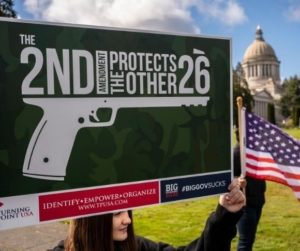Before Joe Biden won the election, his campaign released a list of planned restrictions on the right to keep and bear arms that would make any gun grabber proud. With the revelation of “Joe Biden’s Plan to End Our Gun Violence Epidemic,” we were effectively forewarned – even if some have forgotten after a year of legislative failure and presidential debacles that, with few exceptions, didn’t involve civilian firearms.
But make no mistake: The left declared war on the Second Amendment long ago. Little has been said of it in the media, but the Democrats of the 117th Congress introduced around 100 gun control laws in 2021. Biden tried to appoint a statist gun control activist to lead the ATF – and the attorney general he did manage to get confirmed isn’t any friendlier to armed Americans. Where Congress failed to legislate, Biden’s DOJ may well succeed with gun control by fiat. The Justice Department proposed a rule change back in May of 2021 that redefined some firearms terms in an attempt to banish ghost guns. Now, just one week into 2022, another attack has been launched on federal firearms licensees (FFLs). The message is clear: If we can’t legislate 2nd Amendment rights, we’ll just regulate the makers and sellers of guns out of business.
We Just Want to Be Safe
On Monday, Jan. 3, the Justice Department announced a new rule “to help enable the safe and secure storage of firearms.” According to the new Best Practices Guide for federal firearms licensees (FFLs), any that sell guns to the general public must also have “secure gun storage devices available” by Feb. 3.
 Some have speculated that this will only really affect sellers of used weapons, as new ones tend to come with trigger locks from the manufacturer. That’s a dangerous assumption, however. Yes, trigger locks are a safety device – but they have nothing to do with storage. The rule change explicitly mentions storage and does not include trigger locks in the list of examples. The DOJ release includes a quote from AG Merrick Garland, which might also provide a clue: “Today’s announcements build on the department’s efforts to reduce the risk of firearms falling into the wrong hands.” We’re talking lockable enclosures that can only be opened by a key, combination, or “other similar means” like biometrics.
Some have speculated that this will only really affect sellers of used weapons, as new ones tend to come with trigger locks from the manufacturer. That’s a dangerous assumption, however. Yes, trigger locks are a safety device – but they have nothing to do with storage. The rule change explicitly mentions storage and does not include trigger locks in the list of examples. The DOJ release includes a quote from AG Merrick Garland, which might also provide a clue: “Today’s announcements build on the department’s efforts to reduce the risk of firearms falling into the wrong hands.” We’re talking lockable enclosures that can only be opened by a key, combination, or “other similar means” like biometrics.
Typically, gun stores and pawn shops that sell guns also have a safe or two available. Outdoors, sports, and farm stores that sell guns almost always have several options. In fact, Walmart has been known to carry a safe from time to time. It just makes sense for a business that sells guns to sell other related items – like ammo, accessories, cases – and safes. So, what difference does this rule actually make?
First, not every FFL is a big, brick-and-mortar store. Anyone who can pass a background check and pay the fee can acquire the license and begin selling firearms commercially. Any individual trader, who might only deal in a handful of guns at a time, must now acquire an actual inventory of safe storage devices as well. A handgun safe simply won’t suffice if long guns are sold as well, and just one safe or lockable cabinet won’t either. With just one, a dealer would become non-compliant as soon as it is sold.
Small dealers might get away with just two or three – especially individuals who don’t move much stock – but larger retailers and gun shops simply can’t afford the risk. As soon as that last safe is sold, the business must cease selling firearms until the next shipment comes in. Atwood’s and Walmart can easily survive such an event; the local gun store down the road can’t. And, of course, the now necessary increased stock in storage devices means less money and room on the floor for other items – like firearms or ammo.
Free From Danger, or Free From Freedom?
The Declaration of Independence includes recognition of “certain unalienable Rights, that among these are Life, Liberty, and the pursuit of Happiness.” The right to life and liberty also implies the right to defend both – otherwise, there’s no actual right – and we know the government isn’t held legally liable to protect either, even if it could. That leaves only the individual, or the people, as a whole. The Second Amendment in the Bill of Rights further clarifies this, saying that since a well regulated militia is required to defend a free state, “the right of the people to keep and bear Arms shall not be infringed.”
Unless those foundational documents mean something different – or no longer matter in “modern times” – it follows that any regulation whatsoever is an infringement and is therefore unconstitutional. But, of course, there are gun control laws in effect that haven’t been overturned by the courts, and more could come. That said, the Democrats’ endeavors have been largely unsuccessful this year. With the fight focusing on socialist spending sprees, the gun control measures sat more or less ignored.
Even if those come front and center with Congress at its current composition, few if any are likely to pass. Democrats simply don’t have the support in the Senate. And so, we see a different route taken by the Biden administration: Make life harder for manufacturers and sellers so that there are fewer guns and places to buy them. You can have the right to keep and bear arms as unfettered as you like – but you can’t buy what isn’t for sale.
~ Read more from James Fite.




